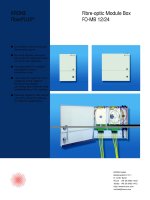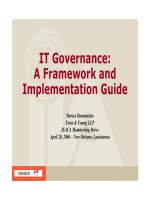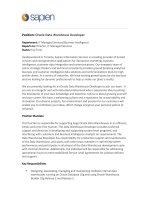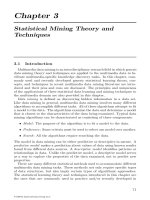Tài liệu Troubleshooting Frame Relay 3 pdf
Bạn đang xem bản rút gọn của tài liệu. Xem và tải ngay bản đầy đủ của tài liệu tại đây (45.73 KB, 10 trang )
1-10 Semester 8 Internetwork Troubleshooting v1.0 - Lab 8.3.4.3 Copyright 2001, Cisco Systems, Inc.
Lab 8.3.4.3: Troubleshooting Frame Relay 3
Frame Relay
Atlas 550
192.168.192.0/24
1/2
2/1
S0/0 S0/0
DLCI 17 DLCI 18
.2
.4
Fa0/0 192.168.200.1/24 Fa0/0 192.168.232.1/24
London Singapore
Objective
Apply the troubleshooting method to a simple Frame Relay network problem.
Scenario
A new Frame Relay connection was installed between London and Singapore
over the weekend. On Monday, both network operators at London and
Singapore call to let you know they are unable reach each other with this new
Frame Relay connection. You check connectivity between the London router
and the Singapore router and find you cannot ping or telnet between the
sites. It is your responsibility to get London and Singapore communicating.
Adtran Atlas 550 Note
If using the Adtran Atlas 550 as your Frame Relay switch, you will see
information about DLCIs (such as DLCI 16) that is not shown in sample outputs
of this lab. These DLCIs are configured on the Atlas 550, but are not being
used for this specific lab. You would not normally see these extra DLCIs, so
any information pertaining to them should be disregarded for this lab.
Step 1
Cable the lab as shown in the diagram.
Load the configuration file called Lab8-3-4-3-LondonBrokenConfig.txt into
the London router. Load the file called Lab8-3-4-3-
SingaporeBrokenConfig.txt into the Singapore router.
Step 2
2-10 Semester 8 Internetwork Troubleshooting v1.0 - Lab 8.3.4.3 Copyright 2001, Cisco Systems, Inc.
Use ping and telnet to check connectivity between London and Singapore.
All ping and telnet attempts from either site to the other should fail. From
each router, ping its directly connected LAN interface. This ping should be
successful.
1. Define the problem you are experiencing.
Step 3
Gather the facts about the situation. The commands listed below are useful for
gathering factual information about each router.
• show interface
• show frame-relay lmi
• show frame-relay pvc
• show frame-relay map
• debug frame-relay lmi
Gather information about the London router first. Console into the London
router and issue a show interface serial 0/0 command. The
highlighted information in the sample output below is useful for troubleshooting
and should be the same as the information in your output.
London#show interface serial 0/0
Serial0/0 is up, line protocol is down
Hardware is PowerQUICC Serial
Internet address is 192.168.192.2/24
MTU 1500 bytes, BW 128 Kbit, DLY 20000 usec,
reliability 255/255, txload 1/255, rxload 1/255
Encapsulation FRAME-RELAY, loopback not set
Keepalive set (10 sec)
LMI enq sent 69, LMI stat recvd 0, LMI upd recvd 0, DTE LMI down
LMI enq recvd 0, LMI stat sent 0, LMI upd sent 0
LMI DLCI 1023 LMI type is CISCO frame relay DTE
Broadcast queue 0/64, broadcasts sent/dropped 0/0, interface broadcasts 0
Last input 00:15:53, output 00:00:05, output hang never
Last clearing of "show interface" counters 00:11:37
Input queue: 0/75/0 (size/max/drops); Total output drops: 0
Queueing strategy: weighted fair
Output queue: 0/1000/64/0 (size/max total/threshold/drops)
Conversations 0/1/32 (active/max active/max total)
Reserved Conversations 0/0 (allocated/max allocated)
5 minute input rate 0 bits/sec, 0 packets/sec
5 minute output rate 0 bits/sec, 0 packets/sec
0 packets input, 0 bytes, 0 no buffer
Received 0 broadcasts, 0 runts, 0 giants, 0 throttles
9 input errors, 0 CRC, 9 frame, 0 overrun, 0 ignored, 0 abort
69 packets output, 897 bytes, 0 underruns
0 output errors, 0 collisions, 22 interface resets
0 output buffer failures, 0 output buffers swapped out
3-10 Semester 8 Internetwork Troubleshooting v1.0 - Lab 8.3.4.3 Copyright 2001, Cisco Systems, Inc.
0 carrier transitions
DCD=up DSR=up DTR=up RTS=up CTS=up
2. Examine the output and list the pertinent facts about the interface.
Issue a show frame-relay lmi command on the London router. The
highlighted information in the sample output below is useful for troubleshooting
and should be similar to the information in your output.
London#show frame-relay lmi
LMI Statistics for interface Serial0/0 (Frame Relay DTE) LMI TYPE = CISCO
Invalid Unnumbered info 0 Invalid Prot Disc 0
Invalid dummy Call Ref 0 Invalid Msg Type 0
Invalid Status Message 0 Invalid Lock Shift 0
Invalid Information ID 0 Invalid Report IE Len 0
Invalid Report Request 0 Invalid Keep IE Len 0
Num Status Enq. Sent 188 Num Status msgs Rcvd 0
Num Update Status Rcvd 0 Num Status Timeouts 187
Checking the status of the LMI is always a good place to start with Frame
Relay.
3. Examine the output. Do you notice anything unusual?
Issue a show frame-relay pvc command on the London router. The
highlighted information in the sample output below is useful for troubleshooting
and should be the same as the information in your output. (Remember to ignore
information about other DLCIs.)
London#show frame-relay pvc
PVC Statistics for interface Serial0/0 (Frame Relay DTE)
Active Inactive Deleted Static
Local 0 1 0 0
Switched 0 0 0 0
Unused 0 0 0 0
DLCI = 17, DLCI USAGE = LOCAL, PVC STATUS = INACTIVE, INTERFACE = Serial0/0
input pkts 0 output pkts 0 in bytes 0
out bytes 0 dropped pkts 0 in FECN pkts 0
in BECN pkts 0 out FECN pkts 0 out BECN pkts 0
4-10 Semester 8 Internetwork Troubleshooting v1.0 - Lab 8.3.4.3 Copyright 2001, Cisco Systems, Inc.
in DE pkts 0 out DE pkts 0
out bcast pkts 0 out bcast bytes 0
pvc create time 00:47:06, last time pvc status changed 00:47:06
4. Notice the PVC for DLCI 17 is INACTIVE. Would this be unexpected?
Issue a show frame-relay map command on the London router.
There should not be any output. Since no LMI messages are being received
and the PVC is inactive, no mapping is taking place. Before any mapping
between the local DLCI and the remote IP address can happen, LMIs must be
exchanged between the routers and the Frame Relay switches, and the PVC
must be active.
Listed below is a summary of pertinent factual information gathered about the
London router.
• The WAN interface serial 0/0 interface and line protocol are up; the
encapsulation is Frame-Relay; the LMI is up; and the LMI type is ANSI.
• LMIs are being sent and received so the router and Frame Relay switch are
exchanging LMIs.
• The PVC for DLCI 17 is active, indicating the PVC between the router and
switch is configured correctly.
• The Frame Relay map is configured correctly.
Issue a debug frame-relay lmi command on the London router. Since
LMIs were not being received, debugging the LMI process gives you a closer
look and will verify LMIs are not being received. Note: Your sequence numbers
may differ.
London#debug frame-relay lmi
Frame Relay LMI debugging is on
Displaying all Frame Relay LMI data
London#
00:18:57: Serial0/0(out): StEnq, myseq 96, yourseen 0, DTE down
00:18:57: datagramstart = 0x1A01ED4, datagramsize = 13
00:18:57: FR encap = 0xFCF10309
00:18:57: 00 75 01 01 00 03 02 60 00
00:18:57:
00:19:07: Serial0/0(out): StEnq, myseq 97, yourseen 0, DTE down
00:19:07: datagramstart = 0x1A01ED4, datagramsize = 13
00:19:07: FR encap = 0xFCF10309
00:19:07: 00 75 01 01 00 03 02 61 00
00:19:07:
00:19:17: Serial0/0(out): StEnq, myseq 98, yourseen 0, DTE down
00:19:17: datagramstart = 0x1A01ED4, datagramsize = 13
00:19:17: FR encap = 0xFCF10309
00:19:17: 00 75 01 01 00 03 02 62 00
00:19:17:
5-10 Semester 8 Internetwork Troubleshooting v1.0 - Lab 8.3.4.3 Copyright 2001, Cisco Systems, Inc.
The "Serial0/0(out):" and "myseq" greater than "0" indicate LMIs are being sent,
but "yourseen 0" indicates LMIs are not being received. Note too that there are
no "Serial0/0(in):" messages which also indicate there are no LMI messages
being received. "DTE down" also means there is a problem communicating
LMIs between the local router and the Frame Relay switch.
Turn the debugging off.
Examine the Singapore router to see if you can learn any new information.
Issue a show interface serial 0/0 command. Your output should be
similar to the sample output below.
Singapore#show interface serial 0/0
Serial0/0 is up, line protocol is up
Hardware is PowerQUICC Serial
Internet address is 192.168.192.4/24
MTU 1500 bytes, BW 128 Kbit, DLY 20000 usec,
reliability 255/255, txload 1/255, rxload 1/255
Encapsulation FRAME-RELAY, loopback not set
Keepalive set (10 sec)
LMI enq sent 227, LMI stat recvd 227, LMI upd recvd 0, DTE LMI up
LMI enq recvd 0, LMI stat sent 0, LMI upd sent 0
LMI DLCI 0 LMI type is ANSI Annex D frame relay DTE
Broadcast queue 0/64, broadcasts sent/dropped 0/0, interface broadcasts 29
Last input 00:00:00, output 00:00:00, output hang never
Last clearing of "show interface" counters 00:38:03
Input queue: 0/75/0 (size/max/drops); Total output drops: 0
Queueing strategy: weighted fair
Output queue: 0/1000/64/0 (size/max total/threshold/drops)
Conversations 0/1/32 (active/max active/max total)
Reserved Conversations 0/0 (allocated/max allocated)
5 minute input rate 0 bits/sec, 0 packets/sec
5 minute output rate 0 bits/sec, 0 packets/sec
228 packets input, 3572 bytes, 0 no buffer
Received 0 broadcasts, 0 runts, 0 giants, 0 throttles
0 input errors, 0 CRC, 0 frame, 0 overrun, 0 ignored, 0 abort
228 packets output, 3192 bytes, 0 underruns
0 output errors, 0 collisions, 1 interface resets
0 output buffer failures, 0 output buffers swapped out
0 carrier transitions
DCD=up DSR=up DTR=up RTS=up CTS=up
5. Compare this output with the output from the London router. What are the
differences?
So far the Singapore router seems to be successfully sending and receiving
LMIs with its Frame Relay switch. Issue a show frame-relay lmi
command to verify this. Your output should appear similar to the sample output
shown below.









